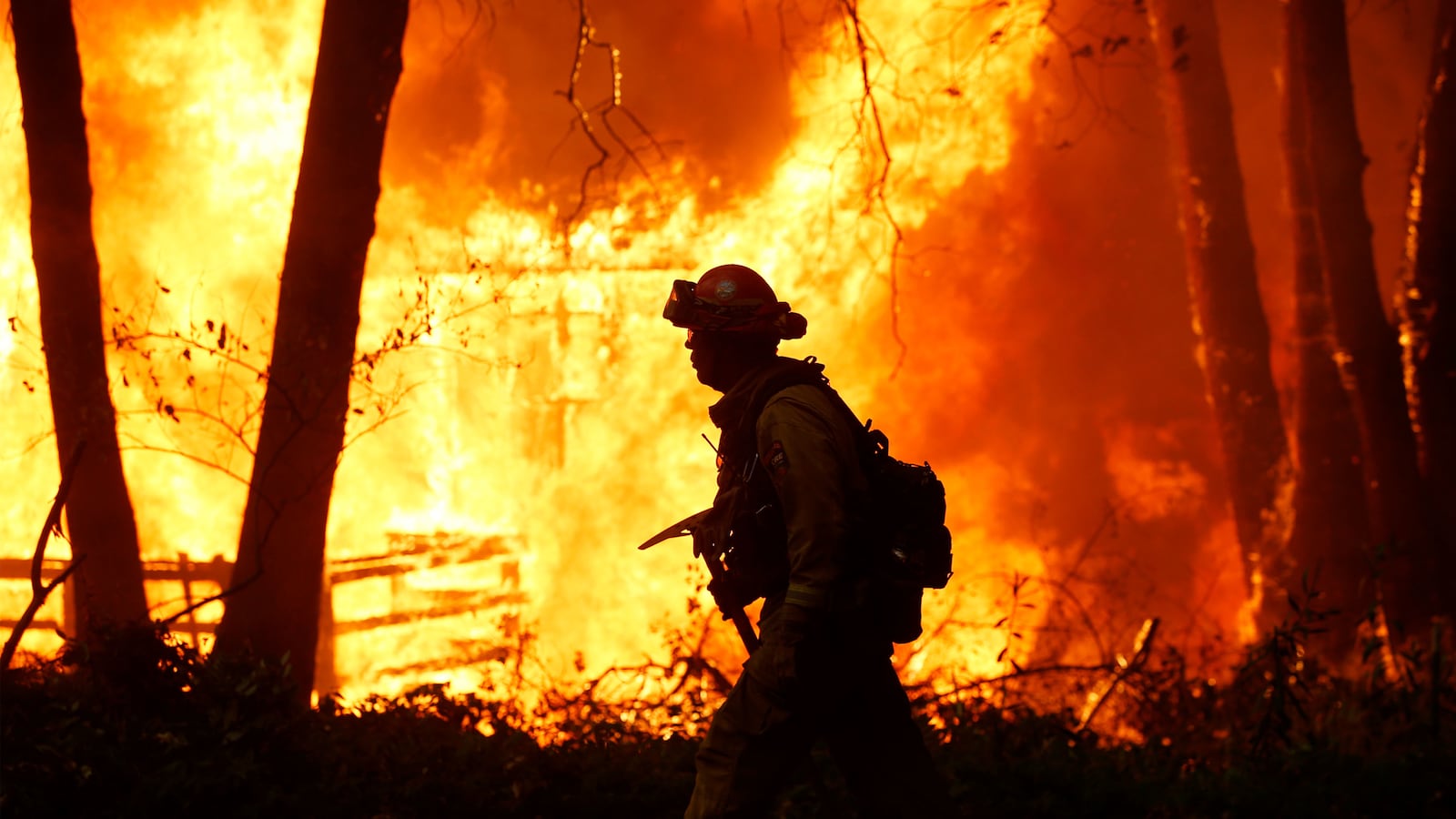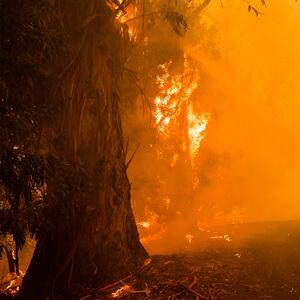Like people, wildfires aren’t born coherent or fully formed. They rarely have one direction or one goal. Fires are fluid and disparate, made up of smaller blazes and embers, some of which might merge into irrational explosions or veer off in different directions. (Scientists have dubbed this odd meandering, not “fire movement” or “fire patterns,” but “fire behavior”). Today, Los Angeles, like Sonoma County, is on fire. The city smells like everyone is having a cookout. On maps, the evacuation zone is drawn in hard lines, starting just five miles from where I’m writing this—a box framed by Mulholland Drive in the north, the 405 in the east, Sunset Boulevard in the south and Temescal Canyon Road in the west. But with hurricane-like winds predicted this week, there remains some uncertainty about just where, exactly, the blaze might go.
Unlike actual flames, the stories of fire have a predictable arc: low humidity, dry fuel, some small ignition (a cigarette, a powerline), ferocious wind, dispatch calls, mobile alerts, confused evacuators, missing heirlooms, lost lives, thousands of tired firefighters, and later, aerial photos of the earth, burnt into a scar. The familiarity makes the worst fire stories the hardest to tell. How do you capture the chaos of a place like Paradise—leveled last year by the Camp Fire, California’s deadliest in a century—when we all know the end? One hundred and fifty thousand acres burned. Nineteen thousand structures were destroyed. Eighty-five people, most of them disabled or elderly, dead.
In that sense, Fire in Paradise, a new documentary directed by Drea Cooper and Zackary Canepari which streams on Netflix this Friday, doesn’t break ground. The tight, 40-minute film isn’t an exercise in narrative form. There’s no narration at all. It’s a time capsule—a minute-by-minute replay, told by the people who lived it and spliced with source footage: dispatch calls, cellphone videos, and clips from an eerily upbeat weatherman. But it’s also a forecast, both for what the state will undergo these next few weeks, and what will replay in fire seasons to come.
Fire in Paradise opens with an omen—at once self-conscious and effective. The camera pans on a forest, dry but unburned. An answering machine beeps in the background and a robocall sets the scene. “This is an important safety alert from Pacific Gas & Electric Company,” the monotone voice says. “Extreme weather conditions and high fire danger are forecasted in Butte County, starting Thursday, November 8, 2018.” Months after that morning, investigators would find the utility company responsible for as many as 10 of the fires which scorched the state last year. It’s another reminder of the film as forecast—this season, PG&E has already taken heat for at least one inferno, and cutting power to millions across the state, leaving some to escape in the dark with little warning.
As the voiceover continues, a square screen appears over the forest, playing a montage of home videos. Families bowl; a man fishes; couples dance and swim; kids dressed as cowboys hop a potato-sack race. “To protect public safety,” the robovoice goes on, “PG&E may temporarily turn off power in your neighborhood or community.” The screen goes black. “Please have your emergency plan ready.”
The account of the following hours unfold through interviews with residents and first responders—when they heard about the fire, when they got scared, when they fled. The most powerful moments don’t come from the speakers describing the fire. One of the unnerving things about extreme natural disasters is how language fails to keep pace with their severity: “It got bad real quick,” one dispatcher says. Another resident echoes: “It felt unreal.”
Instead, the strongest scenes emerge from people describing people. At one point, an auburn-haired teacher named Mary Ludwig recalls boarding a bus filled with students, watching them yawn from the low-oxygen air, and making impromptu masks from the driver’s shirt and the sole water bottle on board. She hoped they wouldn’t work: “We prayed that we would die of smoke inhalation.” Later, resident Joy Beeson, a wry elderly woman with blue nail polish and a pink fleece, describes escaping with her son. “I ran out in my Skechers and my pajamas,” she says. “I was running out of breath, and my son put his hand on my back and said, ‘You’ve got to run now, Mama.’” When Beeson pushed ahead, a burning tree fell where she stood just seconds before: “My son saved my life.” A third survivor, a Cal Fire captain named Sean Norman, remembers evacuating a family that didn’t want to leave. If you don’t go, he told them, you will die. As the fire bore down, Norman couldn’t keep convincing them. He fled. “They survived,” he says, choking up. “They don’t like me very much. But at least they’re around to not like me.”
Still, what makes Fire in Paradise essential viewing isn’t anything the subjects said or the directors captured. It comes from the amateurs, from the cellphone videos filmed from inside cars or while fleeing on foot. Near the end of the movie, the inevitable aerial shot arrives, revealing city blocks reduced to black squares. In the background, newscasters list unthinkable numbers: 77 deaths so far, 1,000 missing people. Then, the camera cuts to a stunning recording. It’s shot by an anonymous man walking through his old town. The landscape is so scorched the tape looks sepia. Only a few faint colors (a fleck of car paint, a blue flame) prove otherwise. The man pans toward the remains of a few cars, narrating in a squeaky voice.
“Now this is the poor guy,” he says, “came down to get my crippled friend out.” He zooms in on the front car. It could be a Honda or a Dodge or a Geo or really any smallish, average car. Identifying markers have all been burned away. “He didn’t make it. None of these people made it down here. These people all got burnt up. I was right down below them here.” The man approaches the shattered windshield, focusing on the hollowed-out front seats. “My friend, you can see he’s dead.” In fact, you can’t see it. The images are unintelligible, all abstract lumps and black lines. But then he pans to a window, and something comes into focus: a blackened skull, and beneath it, bones.


